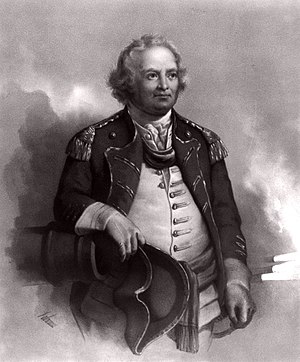Israel Putnam
| Israel Putnam | |
|---|---|

Major General Israel Putnam
|
|
| Nickname(s) | "Old Put" |
| Born |
January 7, 1718 Danvers, Massachusetts |
| Died | May 29, 1790 (aged 72) Brooklyn, Connecticut, US |
| Buried at | Putnam Memorial, Brooklyn, Connecticut, US |
| Allegiance |
|
| Service/branch |
|
| Rank |
Major (UK) Major General (USA) |
| Battles/wars |
French and Indian War Pontiac's War American Revolutionary War |
| Spouse(s) | Hannah Pope |
Israel Putnam (January 7, 1718 – May 29, 1790) was an American army general officer, popularly known as Old Put, who fought with distinction at the Battle of Bunker Hill (1775) during the American Revolutionary War (1775–1783). His reckless courage and fighting spirit became known far beyond Connecticut's borders through the circulation of folk legends in the American colonies and states celebrating his exploits.
He had previously served notably as an officer with Rogers' Rangers during the French and Indian War, when he was captured by Mohawk warriors. He was saved from the ritual burning given to enemies by intervention of a French officer, with whom the Mohawk were allied.
Israel Putnam was born in 1718 in Salem Village (now Danvers), Massachusetts to Joseph and Elizabeth (Porter) Putnam, a prosperous farming Puritan family. His parents opposed the Salem witch trials. With his father-in-law Israel Porter, Joseph Putnam signed the petition on the behalf of the elderly Rebecca Nurse, accused of witchcraft, but the jury overturned its first verdict of innocent, convicting her and sentencing her to death. One of her sisters was also executed in the hysteria of the time.
Putnam married twice, first to Hannah Pope in 1739, the mother of his children. Two years after her death in 1765, he married Deborah Lothrop.
In 1740 at the age of 22, the young Putnam moved west to Mortlake (in a part now Pomfret in northeastern Connecticut), where land was cheaper and easier for young men to buy. According to oral tradition, Putnam killed the last wolf in Connecticut in 1743 with the help of a group of farmers from Mortlake seeking to safeguard their sheep. The tradition describes Putnam crawling into a den with a torch, a musket, and his feet secured with rope, in order to be quickly pulled out. While in the den, he allegedly killed the she-wolf.
...
Wikipedia
